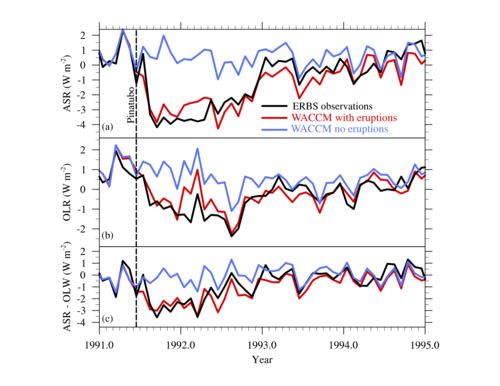3C: WACCM and WACCM-X Community Support
The Whole Atmosphere Community Climate Model (WACCM) and the Whole Atmosphere Community Climate Model with thermosphere and ionosphere extension (WACCM-X) are atmosphere components of CESM with comprehensive numerical representations of processes extending from the Earth's surface to the edge of space. CESM2, released publicly on June 8, 2018, includes new versions of these components: WACCM6 and WACCM-X version 2. WACCM6 is now fully consistent with the atmospheric physics representations in the latest version of the Community Atmosphere Model, CAM6. In addition, WACCM6 and WACCM-X version 2 include many additional significant improvements over the previously released versions.
WACCM6 now matches all of the CAM6 physical parameterizations, and adds significant new capabilities in the middle and upper atmosphere. WACCM6 extends the Modal Aerosol Module (MAM4) to provide a prognostic representation of stratospheric aerosols from volcanic and non-volcanic source gases. Combined with a database of SO2 emissions from volcanic eruptions, this provides a better representation of the chemistry and climate responses to volcanic eruptions. With a default horizontal resolution 4 times greater than CESM1(WACCM), WACCM6 provides improved stratospheric variability, including an internally generated quasi-biennial oscillation, and an improved climatology of sudden stratospheric warmings. WACCM6 includes updated and unified atmospheric chemistry, adding detailed tropospheric chemistry to the middle and upper atmospheric chemistry provided in CESM1(WACCM). The result of these improvements to chemistry, stratospheric variability, and volcanic aerosols is greater skill in hindcasts of the evolution of the Antarctic ozone hole, as well as ozone loss in the Arctic.
WACCM-X version 2 extends through the thermosphere and ionosphere to above 500 km, and now includes global electrodynamics and ion transport. Other ionosphere developments include time-dependent solution of electron and ion temperatures, metastable oxygen ion chemistry, and capability for high-cadence solar forcing. Additional developments of the thermospheric components are improvements to the momentum and energy equation solvers to account for variable mean molecular mass and specific heat, a new divergence damping scheme, and cooling by atomic oxygen fine structure.
ACOM scientists support community use of WACCM and WACCM-X through scientific collaborations and participation in model intercomparisons. In FY2018, 58 scientific papers were published using WACCM, 95% of which were lead by authors outside of ACOM. The CESM Whole Atmosphere Working Group community liaison, ACOM scientist Michael Mills, provides direct support for community users who run these models, including hands-on instruction such as the annual CESM tutorial. He and other ACOM scientists respond to user posts about WACCM and WACCM-X on the CESM Forum, which provides an online knowledge base for users.

Contact
Please direct questions/comments about this page to:
Carl Drews
NSF NCAR | Research IT | ACOM